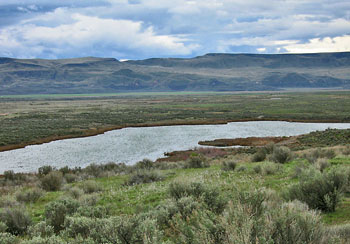Columbia National Wildlife Refuge
The Site
Columbia National Wildlife Refuge (NWR) was established in 1944 as a feature of the Columbia Basin Irrigation Project. The refuge is situated just south of Potholes Reservoir, northwest of the town of Othello. It includes several reaches of lower Crab Creek, the longest creek in the United States. The area is dominated by scabland basalt formations scoured by the Missoula Floods from the last ice age, and the refuge is the primary feature in the Drumheller Channels National Natural Landmark. This arid landscape (8 inches of precipitation annually) in the rain shadow of the Cascade Mountains is dominated by low-elevation shrub-steppe, with scattered lakes, emergent marsh, willow woodland, and ungrazed riparian shrub habitats. Marsh impoundments and cropland are managed primarily for waterfowl and Sandhill Cranes, with two of five management units open to birding year round (the remainder seasonally.)
The Birds
Columbia NWR hosts a variety of shrub-steppe species including Loggerhead Shrike, Say's Phoebe, and the ubiquitous Western Meadowlark. Western Canada Geese and Mallards are common breeders and abundant in migration and winter. Great Egrets, Black-crowned Night-Herons, and Great Blue Herons are common visitors to wetlands from the nearby rookery on Potholes Reservoir. American Bitterns nest, and White-faced Ibises are occasional early-summer visitors. Willow woodlands and riparian shrub attract nesting Lazuli Buntings, Yellow-breasted Chats, Eastern and Western Kingbirds, and abundant Bullock's Orioles. Croplands attract Canada and Cackling Geese and the largest concentration of migrating Sandhill Cranes found in the Pacific Flyway. (The cranes can be enjoyed at the Othello Sandhill Crane Festival in late March.)
Directions and Suggestions
Exit I-90 at the Vantage Bridge over the Columbia River, and continue 41 miles east on Route 26 to Othello, where the refuge office is. Be sure to pick up a map at the office. Birding is most productive from March to June and during September, before seasonal closure of the sanctuary across 2/3 of the refuge from October through February. The Coulee Corridor Scenic Byway route of the Great Washington State Birding Trail describes nine stops at Columbia NWR.
The Corfu area, 12 miles west of Othello, south of Route 26, is the best area for viewing Sandhill Cranes in March and early April, and the woodland along Corfu Road is excellent for migrant songbirds in May. Royal Lake (overlook and kiosk at Byers Road x Road 14.8 SE) hosts abundant waterfowl from October to April. A 23-mile loop starts 5.5 miles northwest of Othello at the intersection of Morgan Lake Road and McManamon Road (Broadway Avenue north from Othello.) Traveling counter-clockwise, take Morgan Lake Road to Route 262 (O'Sullivan Dam Road), then west to Mardon. Next, turn at Road H SE, then go south to McManamon Road (which in Grant County is called Road 12 SE) and return to Morgan Lake Road. The loop includes stops at Marsh Unit 1 (marsh- and shorebirds, spring and summer), the Crab Creek Trail (riparian shrub, especially May through June and September), and the Frog Lake and Marsh Trails (marsh and shrub-steppe, best April and May).
Warning: While rattlesnakes are quite timid, they are common from May to September, as are ticks along trails. Hunting is allowed in areas open to the public (Marsh Unit 1, Corfu).

